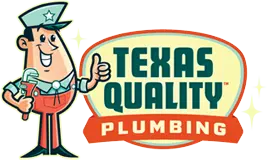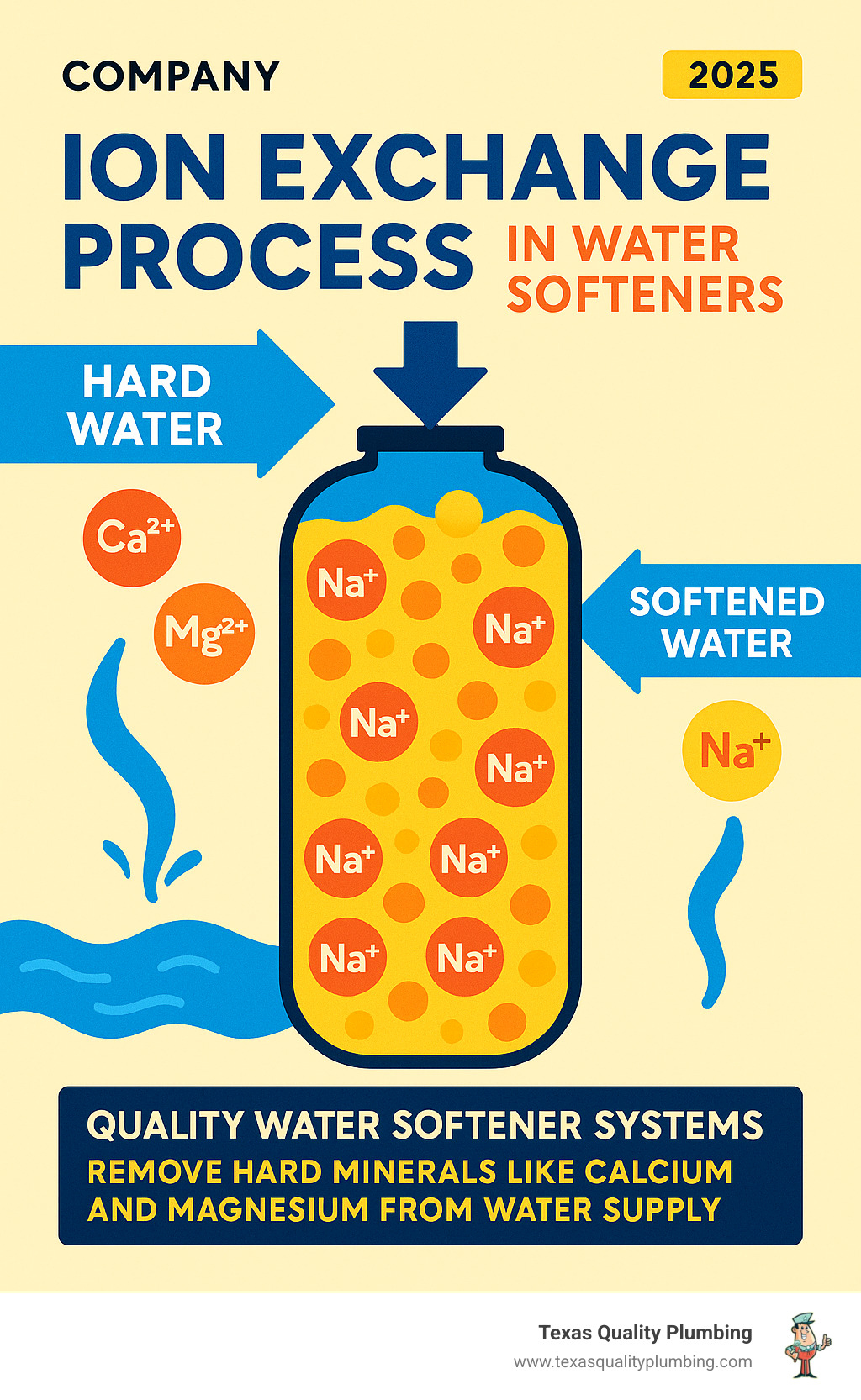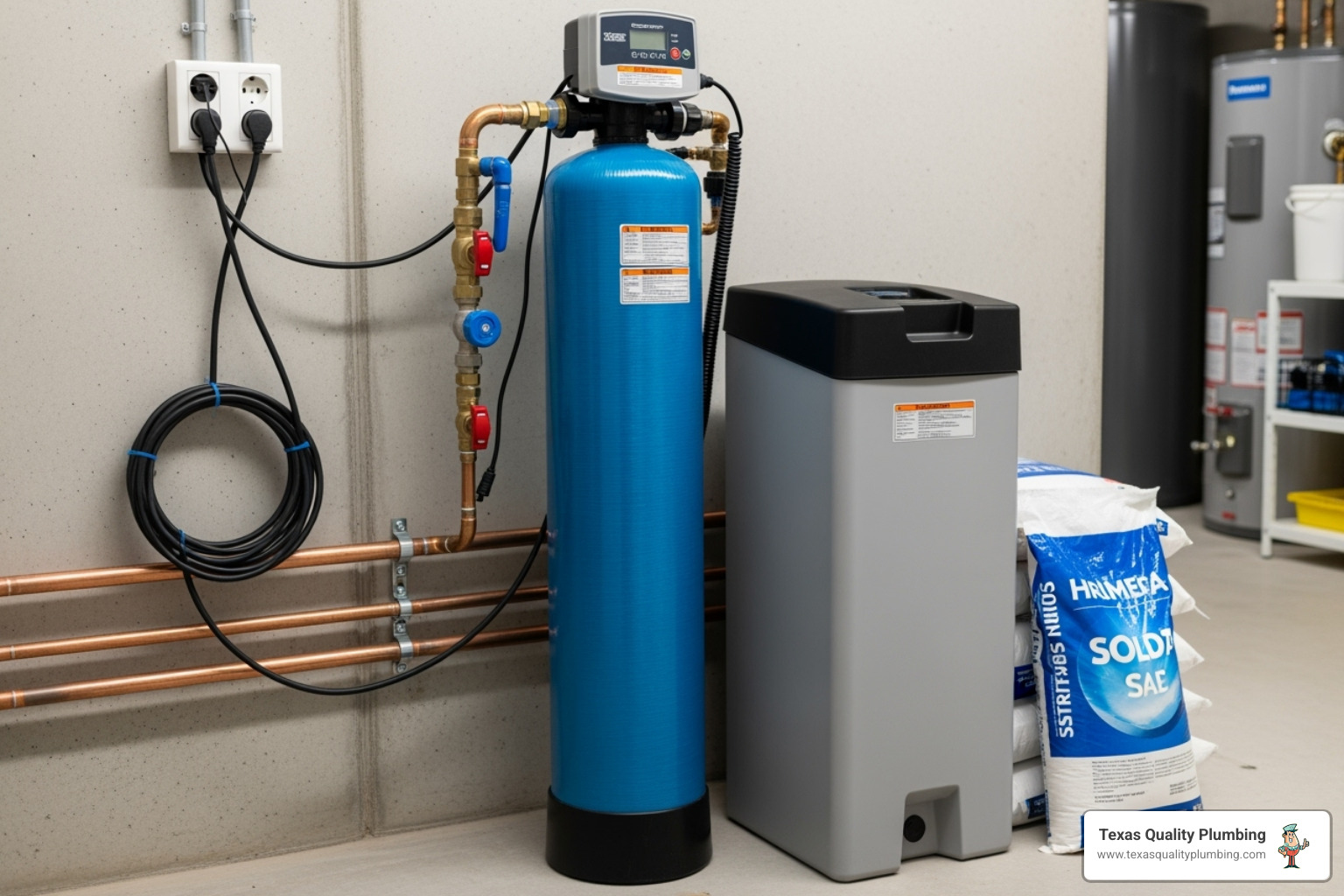Why Hard Water is a Hidden Problem in Your Home
Quality water softener systems remove hard minerals like calcium and magnesium from your home’s water supply through ion exchange. With about 85% of American homes dealing with hard water, the right system can prevent costly repairs and improve daily comfort.
Key Features of Quality Water Softener Systems:
- NSF/ANSI 44 certification for proven hardness removal
- 10% crosslink resin for longer lifespan and chlorine resistance
- Metered regeneration for efficient salt and water usage
- Proper grain capacity sized to your household’s daily water use
- Clack or similar high-quality control valves with 10+ year warranties
- Upflow regeneration technology for 40% better efficiency
Hard water is more than a minor annoyance. That chalky buildup on faucets is also coating your water heater, cutting efficiency by up to 29%. Hard water also shortens appliance lifespans and raises energy bills.
The good news: a quality water softener eliminates these problems while reducing soap and detergent usage by up to 50%. With so many systems on the market, knowing what to look for helps you avoid an expensive mistake.
The Core Components of Quality Water Softener Systems
A quality water softener system uses ion exchange. Resin beads coated with sodium ions swap places with calcium and magnesium, delivering soft water throughout your home.
The process relies on three essentials: the resin tank (where ion exchange happens), the brine tank (salt solution for regeneration), and the control valve (the system’s brain).
Many modern quality water softener systems feature upflow regeneration. Cleaning water flows up through the resin bed, improving regeneration efficiency and cutting salt use by as much as 75% compared to older downflow designs.
The Control Valve: The Brain of the Operation
The control valve tracks usage and decides when to regenerate. Timed regeneration works on a fixed schedule, often wasting salt and water. Metered regeneration counts actual water use and regenerates only when needed.
Newer valves add smart technology, app checks, and leak detection. We often recommend Clack valves for reliability and strong warranties.
Resin Quality and Lifespan
The resin beads do the heavy lifting. Choose 10% crosslink resin for superior durability and chlorine resistance. It can remain effective for up to 20 years, reducing maintenance and replacement costs. For more comprehensive water treatment options, see our water filtration services.
Essential Certifications to Look For
Look for third-party validation. NSF/ANSI 44 certifies hardness reduction and material safety. The WQA Gold Seal adds ongoing audits, and IAPMO confirms code compliance. Learn more at the NSF standards for water treatment systems.
Sizing and Selecting the Right System for Your Household
Getting the right quality water softener system is about balance. An undersized unit regenerates too often; an oversized one wastes money and can be less efficient. Match capacity to how much water you use and how hard it is.
Sizing and Capacity: Finding a Quality Water Softener System for Your Needs
Capacity is measured in grains. First, get your water hardness in grains per gallon (GPG) from your utility or a home test. Next, estimate daily water usage at roughly 75 gallons per person.
Calculation: people x 75 gallons x GPG. Example: 4 people at 10 GPG = 3,000 grains/day (4 x 75 x 10). For efficiency, aim for regeneration every 7–14 days, so choose 21,000–42,000 grains in this example.
On well water, iron and sulfur can reduce resin capacity; you may need pre-treatment or a larger unit. A helpful tool: Water softener sizing calculator.
Salt-Based vs. Salt-Free Alternatives
Salt-based softeners use ion exchange to actually remove hardness minerals, delivering the full soft water benefits but requiring salt and periodic regeneration.
Salt-free conditioners (template-assisted crystallization) do not remove hardness; they change mineral form to reduce scale adhesion. They are low-maintenance and salt-free but do not provide the full soft water feel.
If hardness is high (above ~7 GPG) and you want maximum protection and comfort, salt-based is usually best. For moderate hardness and lower maintenance, salt-free can help with scale. Learn more in our guide on Water Filtration for Hard Water.
Maintenance and Longevity of Quality Water Softener Systems
Salt-based systems mainly need salt refills; check the brine tank every 4–6 weeks and avoid overfilling. Break any salt bridge that forms. A resin cleaner every few months can help, especially with iron.
A well-made softener typically lasts 10–15 years; premium 10% crosslink resin can last 10–20 years. Annual costs are often $40–$100. See more benefits in our Top 10 Benefits Home Water Filter Systems Houston.
The Real-World Impact: Benefits vs. Myths of Softened Water
Installing a quality water softener system changes day-to-day living: better showers, cleaner dishes, easier cleaning, and longer-lasting appliances.
The Tangible Benefits for Your Home and Family
With softened water, soap rinses clean. Skin feels softer, and hair is more manageable. Laundry comes out brighter and softer, and most homes use up to 50% less soap and detergent.
In the kitchen, glasses are spot-free and sparkling. Fixtures stay cleaner longer, and soap scum is dramatically reduced.
Appliances run better and longer. Water heaters can save up to 29% on energy costs without scale. Dishwashers, washing machines, and coffee makers benefit, too. Learn how a quality water softener system boosts performance in our guide on Water Softener Improves Household Water.
Debunking Common Water Softener Myths
- The slippery feel is simply soap rinsing off fully—no mineral film left behind.
- Salty taste is rare; sodium added is typically minimal.
- Softened water is safe to drink for most people. On strict low-sodium diets, add reverse osmosis at the sink.
- For plants, use a bypass spigot or rainwater to avoid soil sodium buildup.
- Softened water is not corrosive to modern plumbing and often protects pipes by preventing scale.
For more on treating other contaminants, see Removing Harmful Contaminants.
Frequently Asked Questions about Water Softeners
Over the years, we’ve helped hundreds of Houston families choose and maintain their water softeners. These are the questions that come up again and again in our conversations with homeowners. Let’s tackle the big ones together.
Is it safe to drink softened water?
This is probably the most common concern we hear, and it’s completely understandable. The short answer? Yes, softened water is safe to drink for most people. Here’s what actually happens during the softening process.
When your quality water softener system removes calcium and magnesium, it replaces them with sodium ions. The amount of sodium added depends entirely on how hard your water was to begin with. For example, if your water has 10 grains per gallon of hardness, each 8-ounce glass will contain about 30 milligrams of sodium. To put that in perspective, that’s roughly the same amount you’d get from eating two slices of white bread.
As a general rule, if your water hardness is below 400 parts per million, there’s really no health concern with drinking the water. However, if you’re on a strict low-sodium diet or your water is exceptionally hard, you might want to consider adding a reverse osmosis system at your kitchen sink. This removes virtually all dissolved solids, including that added sodium, giving you exceptionally pure drinking water.
Many of our customers are surprised to find that their quality water softener system actually improves the taste of their water by eliminating that metallic flavor that hard minerals can create. You can learn more about these improvements in our article about how Water Softeners Improve Water Quality.
How often does a water softener need maintenance?
Here’s the beauty of modern quality water softener systems – they’re remarkably low-maintenance. The main task is simply keeping your brine tank supplied with salt, which we recommend checking every 4-6 weeks. Think of it like checking your car’s oil – it becomes second nature after a while.
Keep your salt level at least halfway full, but don’t pack it to the very top. Overfilling can sometimes cause “salt bridging,” where the salt forms a hard crust that prevents proper dissolving. If you notice your water feeling hard again, a salt bridge might be the culprit.
Beyond salt refills, your system benefits from a few simple annual checks. Resin bed cleaning every few months helps maintain peak performance, especially if your water contains iron. We also recommend a yearly inspection for leaks, ensuring the drain line stays clear, and verifying that your control valve settings haven’t changed.
The resin itself in a quality water softener system – particularly systems with 10% crosslink resin – can last anywhere from 5 to 10 years, sometimes even longer. With this simple care routine, most systems enjoy a healthy lifespan of 10 to 15 years, making them an excellent long-term investment for your home.
What’s the difference between a water softener and a water filter?
This question comes up in almost every consultation, and it’s such an important distinction to understand. While both improve your water quality, they’re solving completely different problems.
A water softener has one specific job: removing those hardness-causing minerals (calcium and magnesium) through ion exchange. It’s your solution for scale buildup, soap scum, dry skin, and dingy laundry. However, it doesn’t tackle other contaminants like chlorine, sediment, bacteria, or chemicals.
A water filter, on the other hand, focuses on removing a wide range of contaminants and impurities. We’re talking about chlorine, sediment, rust, volatile organic compounds, pesticides, heavy metals like lead, and even bacteria or viruses. Filters use various methods – activated carbon, sediment screens, or reverse osmosis membranes – depending on what they’re designed to remove.
Think of it this way: a water softener makes your water “soft,” while a water filter makes your water “cleaner” and “safer” to drink. Depending on your water source and specific concerns, you might benefit from both systems working together. City water customers often pair a carbon filter (to remove chlorine) with a softener (to handle hardness). Well water might require specialized filters for iron or sulfur alongside a quality water softener system.
For a comprehensive look at how these systems can work together in your home, check out our Overview of Houston Water Filtration Systems page.
Conclusion: Investing in Your Home’s Water Quality
Choosing a quality water softener system improves every water-using moment at home. It also drives long-term savings by reducing energy use, cutting soap and detergent by up to half, and protecting appliances from scale. A water heater alone can save up to 29% on energy when free of mineral buildup.
Just as important, soft water helps protect your plumbing and fixtures, stopping hard water damage before it starts. The lifestyle upgrade—softer skin, healthier hair, cleaner dishes, and faster cleanup—comes standard.
While DIY is tempting, professional installation ensures correct sizing, code compliance, and optimal operation from day one. Texas Quality Plumbing serves Houston, Cypress, Spring, Katy, Sugar Land, Richmond, Pasadena, Humble, Tomball, Friendswood, Jersey Village, and Bellaire with customer-focused, efficient service.
Do not let hard water keep wearing down your home. For expert guidance and dependable installation, explore our Houston water filtration services.
Ready to experience the difference? Let us help you Install Water Filtration Systems that transform your water quality for years to come.





